Introduction
In the quest for better health and well-being, understanding the complexities of lower belly fat is essential. This common concern is influenced by a myriad of factors, including:
- Hormonal changes
- Dietary choices
- Lifestyle habits
As individuals navigate their wellness journeys, recognizing the interplay between stress, nutrition, and physical activity becomes crucial. With tailored strategies and support, anyone can embark on a transformative path towards a healthier lifestyle. By embracing effective practices, not only can one reduce stubborn abdominal fat, but also cultivate a holistic approach to health that inspires and uplifts.
The journey to a flatter belly is not just about aesthetics; it's about empowering oneself to thrive and lead by example.
Understanding the Causes of Lower Belly Pooch
Understanding what causes lower belly pooch is essential, as the presence of a belly pooch, commonly known as abdominal fat, can be influenced by several critical factors. Hormonal fluctuations, particularly in estrogen and cortisol, are among the factors that contribute to what causes lower belly pooch by leading to the accumulation of fat in this area. For instance, adherence to the Mediterranean diet is associated with a reduction in the clinical severity of conditions such as PCOS, leading to decreased testosterone levels, which can contribute to reduced abdominal fat.
In addition to hormonal influences, dietary choices significantly affect body management and are related to what causes lower belly pooch; high sugar intake, processed foods, and insufficient protein can exacerbate fat accumulation. Moreover, a sedentary lifestyle—marked by minimal physical activity—can further contribute to what causes lower belly pooch. Research indicates that women who engage in fitness pursuits more than once a week tend to have lower central abdominal fat compared to those who exercise less often, as noted by Guthrie (Fertil Steril 2003).
Stress also complicates matters, often triggering emotional eating and hormonal imbalances, which are examples of what causes lower belly pooch. A case study on energy balance and physical exertion indicates that acute physical exertion often results in a negative energy balance, where energy intake does not increase despite elevated physical exertion levels, raising questions about how regular physical exertion influences long-term energy intake and weight management. By acknowledging these linked factors, individuals can take empowered steps towards enhancing their health and well-being, making informed dietary choices and incorporating physical exercise into their routines.
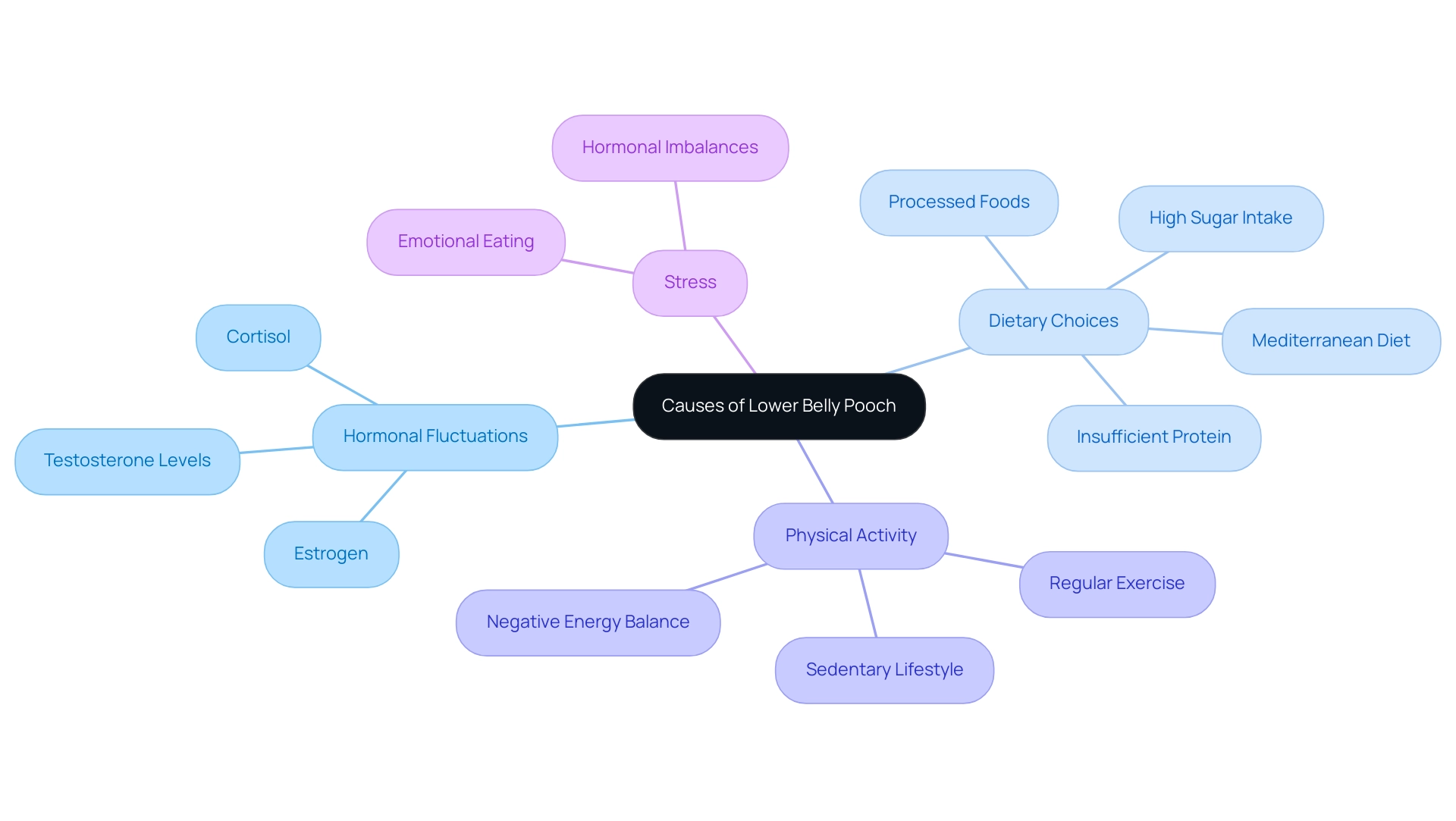
Effective Strategies for Reducing Lower Belly Fat
To effectively tackle what causes lower belly pooch, it is essential to adopt a multifaceted approach, and Foresight Health Coaching offers tailored programs designed to support this journey. Regular physical exercise plays a pivotal role; engaging in at least 200 minutes per week of varied workouts—such as strength training, cardio, and flexibility routines—can significantly enhance fat loss. Research by Jakicic et al. discovered that reduced-obese individuals who participate in this level of activity are less likely to regain mass, underscoring the power of commitment to fitness.
Coupled with this, our personalized fitness coaching provides individuals with custom program development delivered through our app, ensuring that healthy habits become lasting lifestyle changes. The app features tracking tools and resources that help clients stay accountable and motivated throughout their journey.
A balanced diet rich in whole foods—fruits, vegetables, lean proteins, and healthy fats—is vital. Cutting down on sugar and processed food consumption not only helps with management of body mass but also promotes overall well-being. Additionally, incorporating stress management techniques such as mindfulness and yoga, integral parts of our wellness workshops, can help mitigate what causes lower belly pooch by counteracting hormonal impacts that contribute to fat storage.
Don’t overlook the importance of sleep; adequate rest is crucial as poor sleep disrupts hormonal balance and can lead to weight gain. Furthermore, a study titled 'Correlation of Adipose Volume Parameters with Anthropometric Data in Severe Obese Patients' indicates that total adipose tissue volume is significantly correlated with waist circumference, suggesting that this simple measurement can be effective for evaluating abdominal fat.
For practical strategies, consider exploring our downloadable guide with tips for healthy eating and living, as well as our comprehensive health programs tailored for corporate wellness, which include in-person wellness talks and nutrition services.
By consistently implementing these strategies with the support of Foresight Health Coaching, individuals can not only achieve a flatter abdomen but also enhance their overall health, setting a powerful example for their teams.
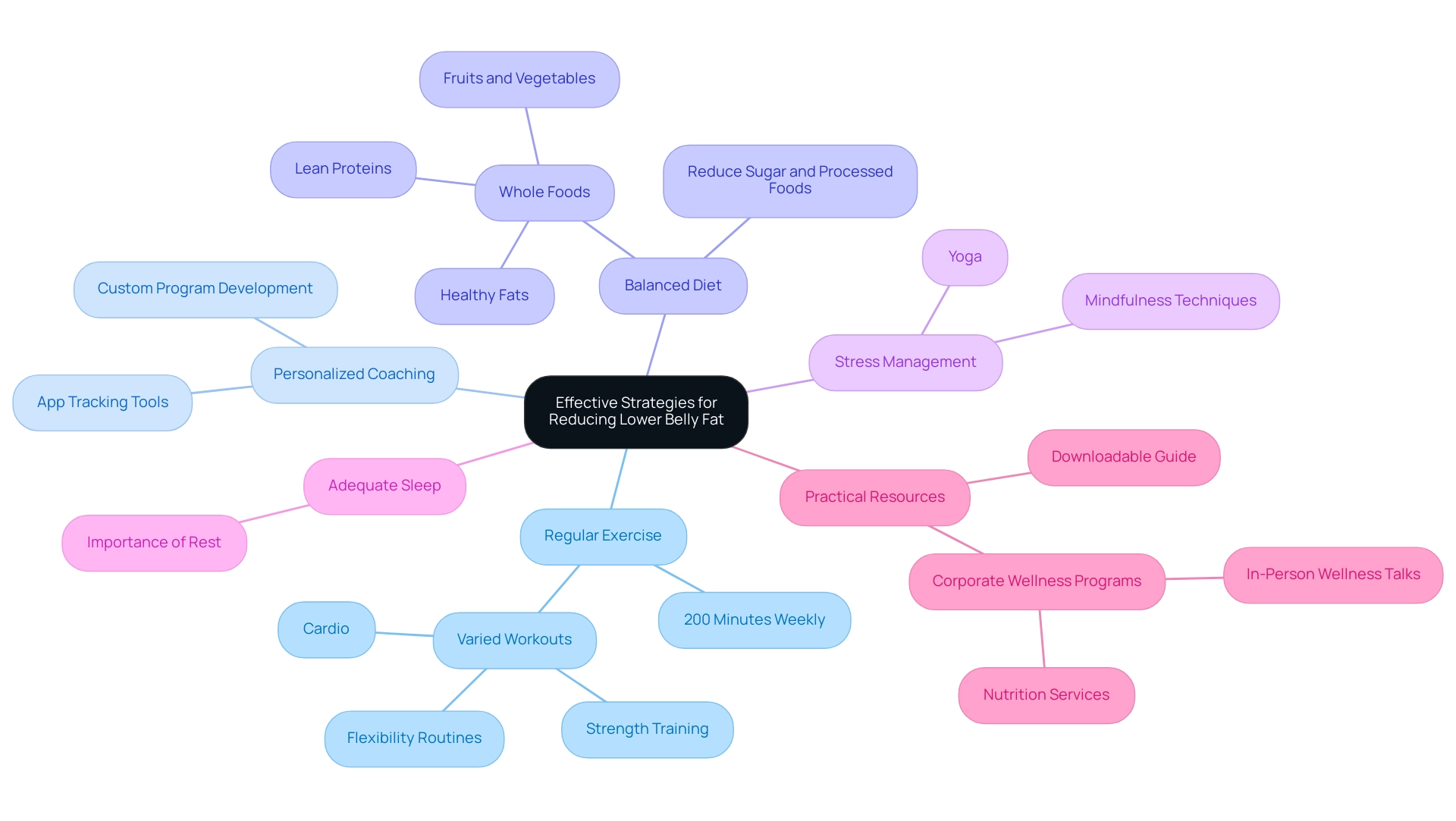
The Impact of Stress on Belly Fat
Chronic stress is a formidable adversary in understanding what causes lower belly pooch. Under stress, the body releases cortisol, a hormone that significantly impacts appetite, leading to increased cravings for sugary and unhealthy foods. Research indicates that individuals classified as high reactors consume significantly more sweet foods over time, underscoring the direct correlation between stress and dietary choices.
Furthermore, emotional eating often arises as a coping mechanism during stressful periods, exacerbating this issue. As Nancy Hammond, M.D., observes, 'Comprehending the influence of stress on our bodies is essential for managing body composition effectively.' This medically reviewed perspective emphasizes the need for a comprehensive understanding of these phenomena.
To combat what causes lower belly pooch and the adverse effects of stress and cortisol on weight, it becomes essential to prioritize stress management techniques. Our customized corporate wellness programs include practices such as:
- Meditation
- Deep breathing exercises
- Regular physical activity
These practices not only reduce cortisol levels but also enhance overall well-being. By providing individualized support through dedicated health coaches and a customized app, we help employees manage their health effortlessly.
A recent study titled 'Effect of Nutritional Support on Mortality' evaluated how nutritional interventions impacted health outcomes, revealing that such interventions could significantly influence mortality rates, particularly for individuals with elevated cortisol levels. By adopting a holistic approach that integrates stress management strategies, individuals can effectively address what causes lower belly pooch, enhance mental well-being, and ultimately improve workplace productivity. Furthermore, these corporate wellness programs yield multi-layered benefits, such as reduced absenteeism and decreased healthcare costs, creating a new value structure within your firm.
Healthier employees are more engaged, productive, and less likely to experience burnout, fostering a healthier, more productive environment for everyone.
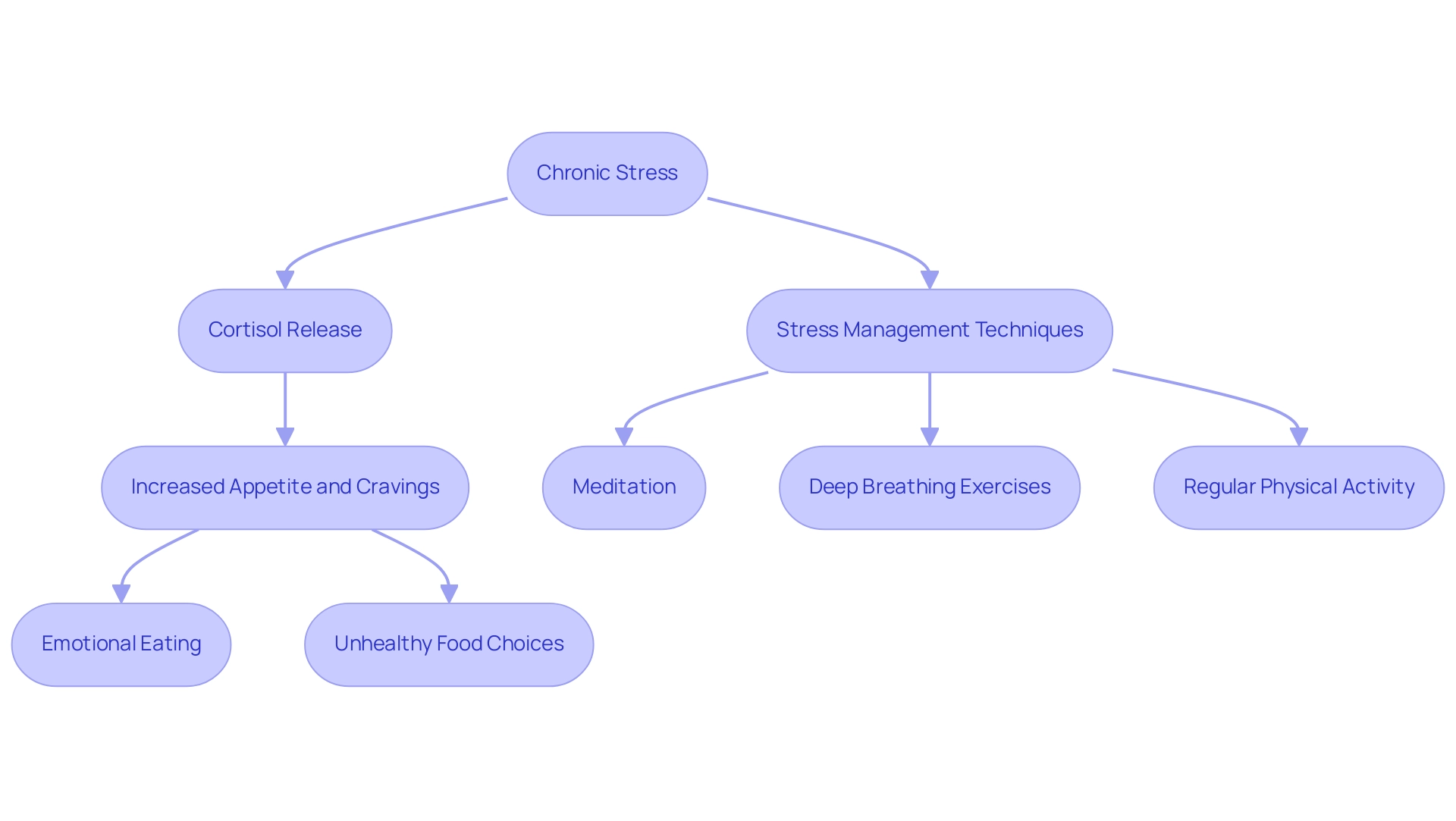
The Role of Nutrition in Managing Lower Belly Fat
Nutrition is a crucial component in learning what causes lower belly pooch and managing it effectively. Adopting a diet focused on whole, unprocessed foods can significantly influence management of body composition. High-fiber foods, including a vibrant array of vegetables, fruits, and whole grains, not only aid in promoting satiety but also help reduce overall calorie intake.
Statistically, at 7 years, 25 percent of dieters sustain a reduction of 10 percent of their initial body mass, highlighting the long-term benefits of dietary changes. As observed by the Institute of Medicine, "an additional factor identified among successful managers of body mass is individual readiness, that is, strong personal motivation to succeed in body management." This insight underscores the importance of motivation in dietary choices.
Incorporating healthy fats from sources such as avocados, nuts, and olive oil can further enhance metabolic health. Staying hydrated and minimizing sugary drink consumption are also key strategies for effective management of body composition. Furthermore, recent research on metabolic phenotyping emphasizes the significance of understanding individual metabolic responses to dietary changes, providing a scientific basis for the nutritional strategies discussed.
By making informed and conscious dietary choices, individuals can cultivate a sustainable eating pattern that not only supports their personal goals of reducing belly fat but also helps to understand what causes lower belly pooch and promotes overall well-being. As we look to 2024, it's vital to recognize the impact of nutrition on our health and the power of high-fiber foods in achieving lasting weight management success.
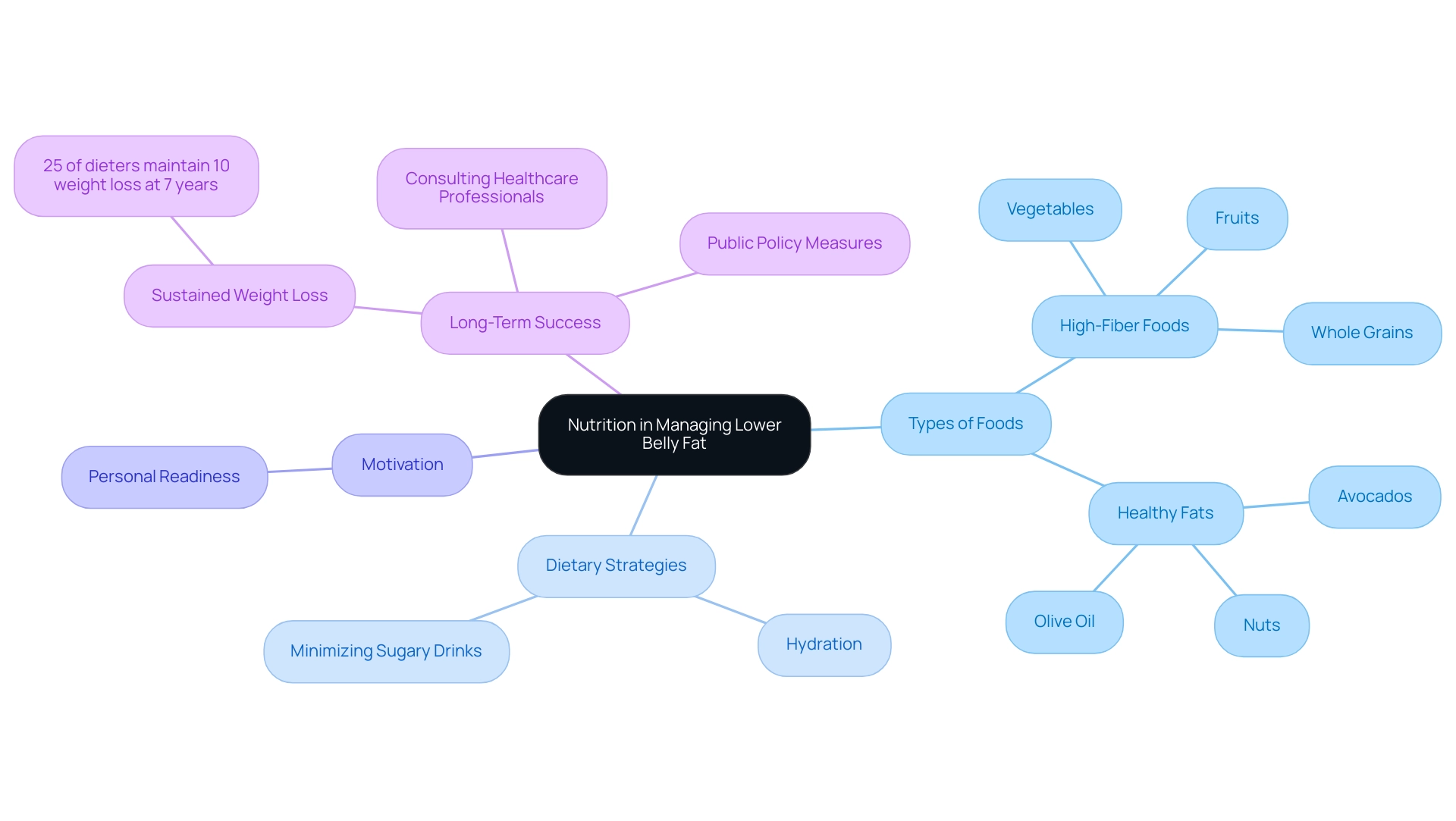
The Importance of Physical Activity
Incorporating regular physical exercise into daily routines is not just a recommendation—it's a crucial step towards addressing what causes lower belly pooch and enhancing overall health. Our comprehensive wellness coaching app supports this journey by offering personalized workouts tailored to individual goals, along with nutrition guidance and daily programming for effective progress tracking—all conveniently located in one place to eliminate the hassle of searching for different wellness resources. A balanced combination of aerobic exercises, such as running, cycling, or swimming, alongside strength training, can significantly elevate metabolism and foster fat loss.
Experts recommend targeting at least 150 minutes of moderate-intensity aerobic exercise each week, supplemented by muscle-strengthening workouts on two or more days. Even minor lifestyle changes—such as choosing stairs instead of elevators or engaging in brisk walks during breaks—can dramatically enhance physical exertion levels. Embrace a consistent exercise routine, and you’ll not only work towards achieving a flatter abdomen but also experience a surge in energy and overall well-being.
As Helen West, a registered dietitian, emphasizes, 'You should consult a healthcare professional before starting a new HIIT routine, especially if you have known heart concerns.' Consider the inspiring journey of singer Meghan Trainor, who embraced weightlifting and saw significant changes in her health, shedding pounds and boosting her energy levels. Additionally, our app facilitates direct messaging with coaches for personalized support and community engagement for motivation.
The app also includes video demonstrations and movement flows, perfect for visual learners who prefer to see exercises in action before trying them out themselves. It's important to track progress through measurements and how clothes fit, as these can provide more informative insights into fat loss than relying solely on the scale. According to the article identified by PMID: 34630157, regular physical activity is linked to a noticeable reduction in lower belly fat, which helps in understanding what causes lower belly pooch, reinforcing the need for consistent exercise.
By committing to these practices and utilizing our wellness coaching app, you can inspire your team to prioritize their health and well-being, making a profound impact on their lives. The credibility of these findings is further supported by the research available under PMCID: PMC8497689.
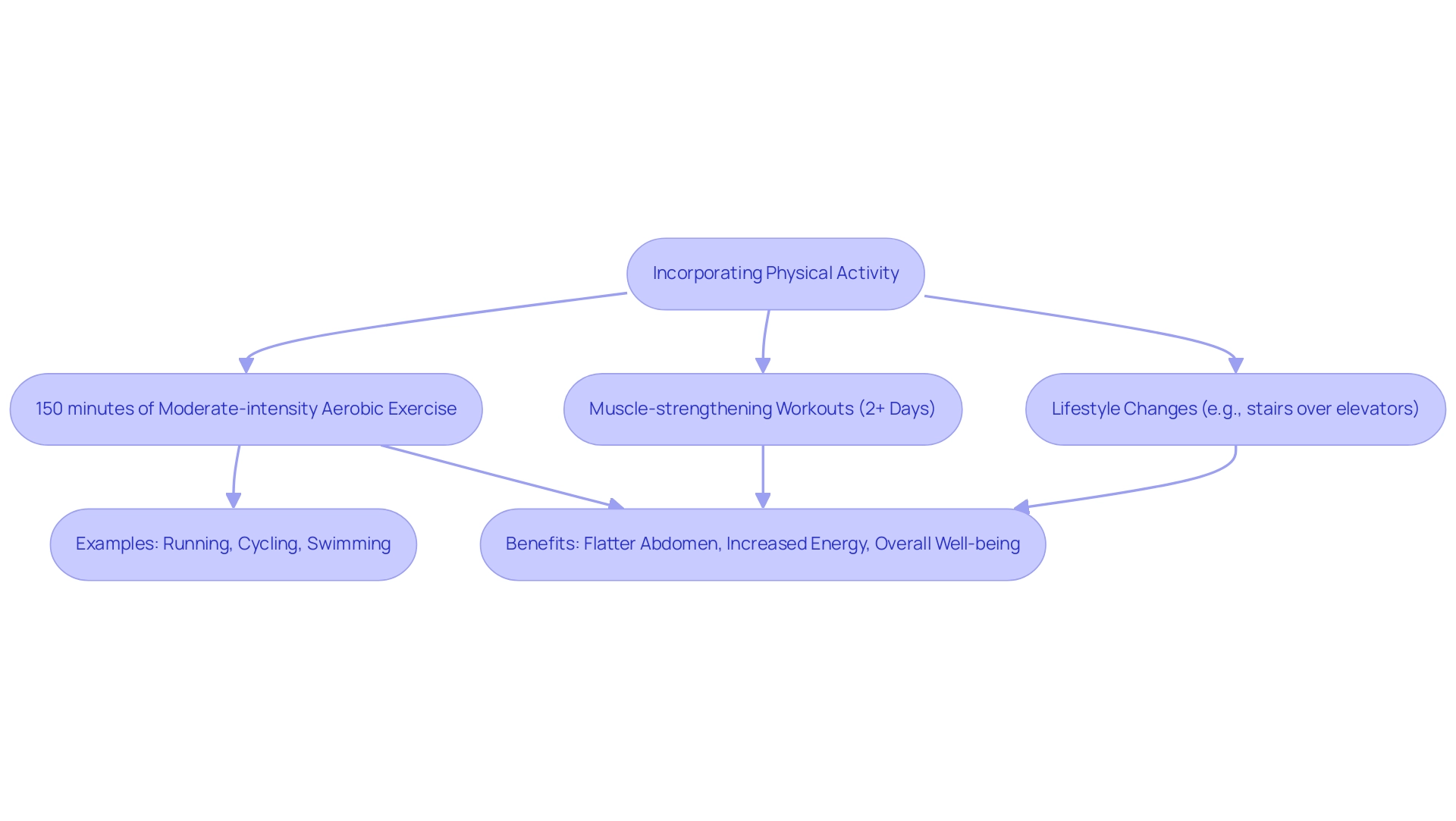
Conclusion
Understanding the intricacies of lower belly fat reveals a multifaceted journey towards improved health and wellness. Hormonal influences, dietary choices, lifestyle habits, and stress all intertwine, significantly impacting abdominal fat accumulation. By adopting a holistic approach—incorporating balanced nutrition, regular physical activity, and effective stress management—individuals can take empowered strides towards achieving their health goals.
Implementing practical strategies, such as engaging in consistent exercise and making informed dietary choices, can lead to sustainable changes. The integration of personalized coaching and tailored wellness programs further enhances the potential for success, fostering a supportive environment that drives motivation and accountability. As individuals commit to these practices, not only do they work towards a healthier body, but they also cultivate a mindset that prioritizes overall well-being.
Ultimately, the pursuit of reducing lower belly fat transcends mere aesthetics; it embodies a broader commitment to health that inspires and uplifts. By embracing these transformative strategies, individuals can set powerful examples for their peers, creating a ripple effect that promotes a culture of wellness within their communities. The time to act is now—prioritize health, empower yourself, and inspire others on this journey towards a vibrant, fulfilling life.
Frequently Asked Questions
What causes lower belly pooch?
Lower belly pooch, or abdominal fat, can be caused by several factors including hormonal fluctuations (especially in estrogen and cortisol), dietary choices (high sugar intake, processed foods, insufficient protein), a sedentary lifestyle, and stress.
How do hormonal fluctuations contribute to lower belly pooch?
Hormonal fluctuations, particularly in estrogen and cortisol, can lead to fat accumulation in the lower belly area. Conditions like PCOS, influenced by these hormones, can also affect testosterone levels and contribute to abdominal fat.
What dietary choices can influence lower belly pooch?
A diet high in sugar and processed foods, along with insufficient protein intake, can exacerbate fat accumulation in the lower belly.
How does physical activity impact lower belly pooch?
A sedentary lifestyle contributes to lower belly pooch, while engaging in fitness activities more than once a week is associated with lower central abdominal fat.
What role does stress play in causing lower belly pooch?
Stress can trigger emotional eating and hormonal imbalances, both of which contribute to the development of lower belly pooch.
What approach should be taken to address lower belly pooch?
A multifaceted approach is essential, including regular physical exercise, a balanced diet, stress management techniques, and adequate sleep.
What type of exercise is recommended for reducing lower belly pooch?
Engaging in at least 200 minutes per week of varied workouts, including strength training, cardio, and flexibility routines, is recommended for significant fat loss.
How can Foresight Health Coaching assist individuals in managing lower belly pooch?
Foresight Health Coaching offers tailored programs, personalized fitness coaching, and an app with tracking tools and resources to help clients develop healthy habits and stay accountable.
Why is sleep important in managing lower belly pooch?
Adequate sleep is crucial because poor sleep can disrupt hormonal balance, potentially leading to weight gain and increased abdominal fat.
What additional resources does Foresight Health Coaching provide?
Foresight Health Coaching offers downloadable guides with tips for healthy eating and living, as well as comprehensive health programs tailored for corporate wellness.

